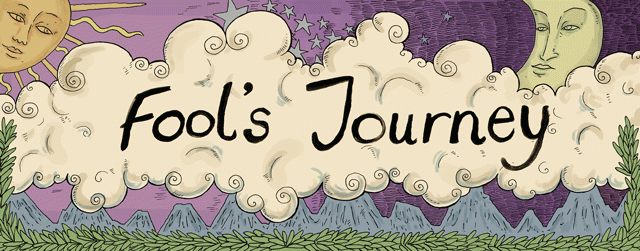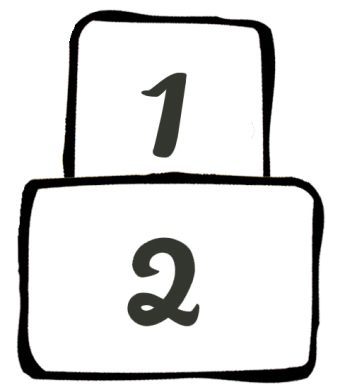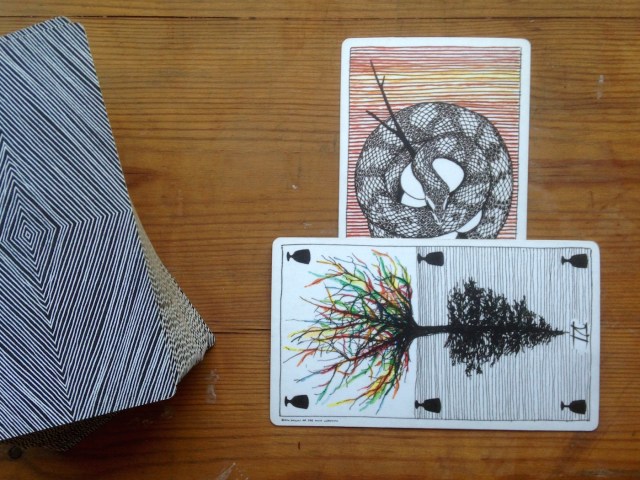
Header by Rory Midhani
My favourite tarot spread isn’t the Celtic cross, or any of the long, rambling creations I’m always coming up with. It’s a quick, dirty, two-card spread that takes just a minute or two to do, and provides loads of insight and clarity.
I call it the Two-Card Cross.
It’s perfect for moments when you feel stuck and you don’t know why, or you want to get to the heart of an issue, or you want advice for your next step forwards.
Shuffle your cards, keeping your question in mind if you have one, or clearing your mind completely. When you’re ready, lay the first card. Then lay a second card across it, like this:

1. Situation / 2. Challenge
Just as in the Celtic cross, the first card represents the heart of your question — the situation itself, and the second card represents something that is ‘crossing’ you — a challenge you’re facing or a weight you’re carrying, or something else that is impacting on your situation and needs to be considered before a solution can be found.
Example:
The day I sat down to write this post, I felt weirdly anxious. I couldn’t sit still, my stomach was in knots and I could feel myself acting weird with people. I asked my cards WTF was up with me.
I got the Mother (aka Queen) of Wands, crossed by the Six of Cups. So my situation was represented by a confident, high-achieving, self-possessed creative person — a card I happen to really respect and love, and a card I often want to channel. My crossing card, the ‘challenge,’ was represented by the Six of Cups. Looking at those deep, colourful roots, it seemed to suggest a need to go back to basics. What did the cards tell me together? That I had put a lot of pressure on myself today. I looked at my to-do list: a long list of creative, exciting tasks that I couldn’t get done in a whole week, let alone a day. Perhaps I was expecting too much of myself today. The Six of Cups suggests simplicity. Finding joy in the little things. A more childlike view of creativity. I don’t have to be the Queen of Wands every day.

Cards are from The Wild Unknown Tarot by Kim Krans
These two cards can be read in so many different ways. By subtly altering the position names, you can produce very different readings. Try adapting your spread using any of the following:
1. Aim / 2. Blockage
Here, the first card represents the desired outcome, the thing you want to achieve. The second is the thing that is preventing this from happening.
1. Blockage / 2. Solution
The first card is the problem faced by the querent. The second represents a way forwards, an approach which can help to address the blockage or solve the problem.
1. Querent / 2. Adversary
Here, the first card represents the person asking the question, and the second is a person — or the actions of a person — who is holding them back.
1. Ideal / 2. Settling for
The first card is what you really want, whereas the second represents the situation as is, what you are ‘settling for.’ Why might this be?
1. Situation / 2. Extra info
With this version, the first card represents you or your situation, right now. The second card offers you a little extra info into what’s going on.
The two-card cross is really useful for practicing interpreting cards in pairs. Rather than simply laying the cards side-by-side, there is the added information provided by the fact that one card is crossing the other. This could mean all kinds of things!
It’s also a very handy starting point for building your own spreads — many of my bigger spreads build off these two crossing cards. If you feel so inclined, pull a third card after you’ve read the two, asking a further question as you do.
And if you’re super into this spread, you’ll enjoy The Heart of the Tarot by Signe E. Echols, Robert Mueller and Sandra A. Thomson, a book entirely dedicated to this little spread and filled with ideas for interpreting cards in pairs.



Definitely one of my favourite and most helpful spreads.
@elrona Right? Sometimes the little things are the best :)
Fabulous, also perfect for beginners like me while getting to know the different cards more deeply!
@blanche Absolutely! If you currently do a ‘daily draw’ (i.e. draw a card each day and spend a little time with it) you could try doing a two-card cross instead sometimes, and practice noticing interactions.
Great idea, I’ll try this, thanks.
Great exercise for this morning! I’m finding it almost creepy how appropriate the cards are. I was thinking about money stresses this morning, and immediately pulled the Five of Pentacles.
https://www.etsy.com/shop/killthepatriarchy
I have a question! How do you tell if the crossing card, the sideways one, is right side up or not? Which direction do you look at it from?
I’ve also heard of, I think, a 3 card spread where the 1st two are like this one, and represent a relationship, I think, and the 3rd card is what you’ll take away from it?
Also the Wild Unknown deck is soooo gorgeous. But I rarely read tarot, so there’s no reason for me to get it hehe
I was wondering about this too (which way the second card should be interpreted, or just what feels best)?
I believe crossing cards are typically read as upright, no matter what.
Question for you, Beth: I’ve thought of drawing my own deck of tarot cards, for drawing practice and also so that I don’t have to buy one haha. Should I save up and buy one, though, for my first deck?
Dwerp, it’s supposed to say Beth and Readers. I need to proofread.
http://littleredtarot.com/make-your-own-tarot-deck/ -This is an awesome post Beth wrote about someone who did exactly that. I think it’s a really cool idea, because as you work on it, you’ll definitely get acquainted with the meanings of the cards, and probably as you work on drawing your cards the meanings will seep into you, take on additional layers and associations…and you’ll have such an intimate connection with your cards, with every choice you’ve made. Like, even if some of the symbolism you end up using is not totally clear to you in the moment, or takes on additional meanings later on, there’s still no way that your own tarot deck would ever feel like an alien thing you have to confront and interpret, you know? You’ll never be like “Ugh, why are there lobsters on the moon card?” I really really hope you try this! Even if you don’t end up doing the whole massive project, you’ll gain a lot from whatever cards you do make :)
Thanks @ratscantknit!! Also @stagename, that DIY deck interview is actually with a fellow Autostraddler, @juliet!
You might also like this post about another home-made deck: http://littleredtarot.com/a-simple-affordable-self-published-tarot-deck/
This helped me out so much!!
Thanks for this article Beth! I’m going to spend some time with my Steampunk Tarot tonight :)
I was wondering if the book you recommended has ideas for more two-card positions or just focuses on situation/challenge. I don’t feel like I need another book on card meanings, but would like more ideas on different approaches to small readings. Thank you! :)
Hey Lindsay! The book focuses on situation/challenge and possible ways of interpreting combinations of cards in those positions, though if I remember right it does explore the purpose and benefits of shorter readings.